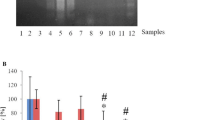Abstract
The addition of aluminum-maltol complex to PC12D cells induced a time-dependent and concentration-dependent growth inhibition as well as cell death, whereas aluminum chloride or maltol alone did not affect the viability of PC12D cells. Apoptosis of differentiated PC12D cells was assessed by using terminal deoxynucleotidyltransferase-mediated 2′-deoxyuridine-5′-triphosphate nick end labeling (TUNEL) technique to detect DNA strand breaks in situ. The number of TUNEL-positive cells treated with aluminum-maltol increased with time in the treatment cultures. The ability of aluminum ion to elevate intracellular reactive oxygen species was determined by fluorescence in PC12D cells loaded with the oxidant-sensitive dye 2′,7′-dichlorofluorescin diacetate. Aluminum ion incorporated to PC12D cells causes apoptotic cell death by enhancing the generation of reactive oxygen species.
Similar content being viewed by others
References
Bertholf RL, Herman MM, Savory J, Carpenter RM, Sturgill BC, Katsetos CD, van den Berg SR, Wills MR. 1989 A long-term intravenous model of aluminum maltol toxicity in rabbits: Tissue distribution, hepatic, renal, and neuronal cytoskeletal changes associated with systemic exposure. Toxicol Appl Pharmacol 98, 58–74.
Bondy SC, Guo-Ross SX, Pien J. 1998 Mechanisms underlying aluminum-induced potentiation of the pro-oxidant properties of transition metals. NeuroToxicol 19, 65–72.
Crapper DR, Krishman SS, Dalton AJ. 1973 Brain aluminum distribution in Alzheimer's disease and experimental neurofibrillary degeneration. Science 180, 511–513.
Fournel S, Genestier L, Rouault JP, Lizard G, Flacher M, Assossou O, Revillard JP. 1995 Apoptosis without decrease of cell DNA content. FEBS Lett 367, 188–192.
Fraga CG, Oteiza PI, Golub MS, Gershwin ME, Keen CL. 1990 Effects of aluminum on brain lipid peroxidation. Toxicol Lett 51, 213–219.
Ganrot PO. 1986 Metabolism and possible health effects of aluminum. Environ Health Perspect 65, 363–441.
Gavrielli HG, Sherman Y, Ben-Sasson SA. 1992 Identification of programmed cell death in situ via specific labeling of nuclear DNA fragmentation. J Cell Biol 119, 493–501.
Hansson M, Asea A, Ersson U, Hermodsson S, Hellstrand K. 1996 Induction of apoptosis in NK cells by monocyte-derived reactive oxygen metabolites. J Immunol 156, 42–47.
Hironishi M, Kordek R, Yanagihara R, Garruto RM. 1996 Maltol (3-hydroxy-2-methyl-4-pyrone) toxicity in neuroblastoma cell lines and primary murine fetal hippocampal neuronal cultures. Neurodegeneration 5, 325–329.
Martin RB, Savory J, Brown S, Bertholf RL, Wills MR. 1987 Transferrin binding of Al3+ and Fe3+. Clin Chem 33, 405–407.
Martin RB. 1986 Citrate binding at Al3+ and Fe3+. J Inorg Biochem 28, 181–187.
Mills EM, Gunasekar PG, Pavlakovic G, Isom GE. 1996 Cyanideinduced apoptosis and oxidative stress in differentiated PC12 cells. J Neurochem 67, 1039–1046.
Nixon RA, Clark JF, Logvinenko KB, Tan MKH, Hoult H, Grynspan F. 1990 Aluminum inhibits calpain-mediated proteolysis and induces human neurofilament proteins to form proteaseresistant high molecular weight complexes. J Neurochem 55, 1950–1959.
Perl DP, Brody AR. 1980 Alzheimer's disease: X-ray spectrometric evidence of aluminum accumulation in neurofibrillary tangle-bearing neurons. Science 208, 297–299.
Perl DP, Good PF. 1991 The association of aluminum, Alzheimer's disease and neurofibrillary tangles. J Neural Transm 24, 205–211.
Perl DP, Gajdusek DC, Garruto RM, Yanagihara RT, Gibbs CJ. 1982 Interneuronal aluminum accumulation in amyotrophic lateral sclerosis and Parkinson-dementia of Guam. Science 217, 1053–1055.
Sato T, Hashizume M, Hotta Y, Okahata Y. 1998 Morphology and proliferation of B16 melanoma cells in the presence of lanthanoid and Al3+ ions. BioMetals 11, 107–112.
Vorbrodt AW, Trowbridge RS. 1993 Aluminum-induced alteration of surface anionic sites in cultured brain microvascular endothelial cells. Acta Neuropathol 86, 371–377.
Yoshino M, Murakami K. 1992a Aluminum: A pH-dependent inhibitor of NADP-isocitrate dehydrogenase from porcine heart. BioMetals 5, 217–221.
Yoshino M, Yamada Y, Murakami K. 1992b Inhibition by aluminum ion of NAD-and NADP-dependent isocitrate dehydrogenases from yeast. Int J Biochem 24, 1615–1618.
Yoshino M, Ito M, Haneda M, Tsubouchi R, Murakami K. 1999 Prooxidant action of aluminum Ion. Stimulation of iron-mediated lipid peroxidation by aluminum. BioMetals 12, 237–240.
Author information
Authors and Affiliations
Corresponding author
Rights and permissions
About this article
Cite this article
Tsubouchi, R., Htay, H.H., Murakami, K. et al. Aluminum-induced apoptosis in PC12D Cells. Biometals 14, 181–185 (2001). https://doi.org/10.1023/A:1016677319875
Issue Date:
DOI: https://doi.org/10.1023/A:1016677319875




